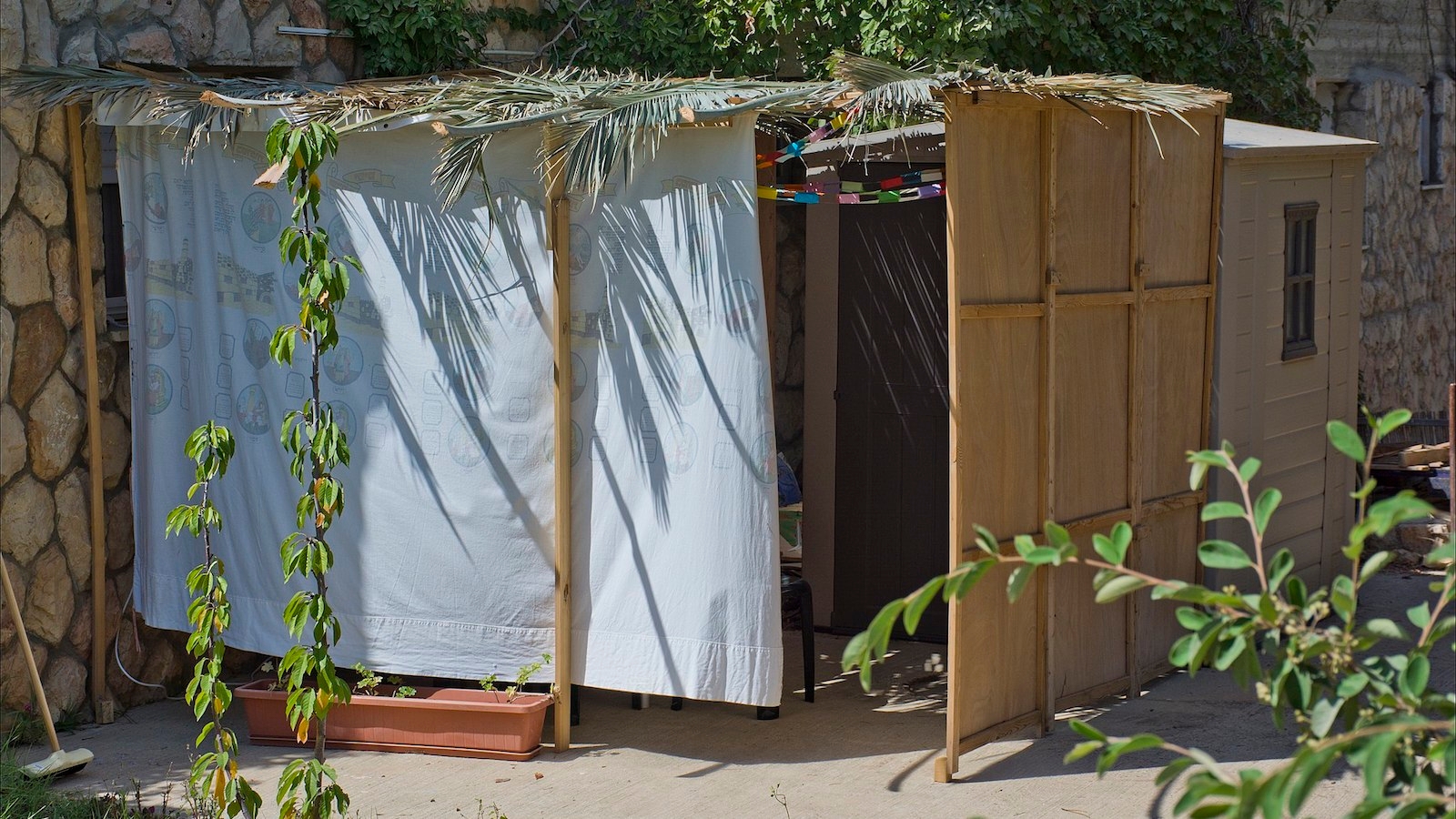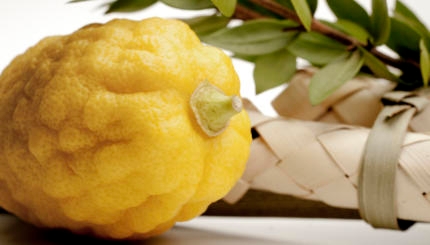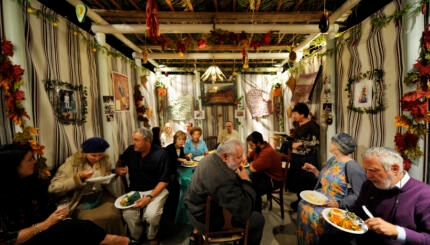The theological and agricultural dimensions of Sukkot converge in the symbolism of the temporary shelter, covered with cut branches, called the sukkah. According to traditional sources, the sukkah commemorates both the temporary shelters in which farmers dwelt at harvest time to be close to their crops and those of the Israelites as they wandered in the desert.
Both the holiday’s celebration of the harvest and its remembrance of Israel’s vulnerability in the desert point to human dependence on God’s beneficence and the consequent obligation to give thanks to God. The home customs of Sukkot also encompass both dimensions.
Basic Requirements for the Sukkah
The sukkah (plural: sukkot) gives the holiday its name, and one of its defining commandments is for Jews leshev ba-sukkah, “to dwell in the sukkah.” A sukkah may take a variety of forms—from a relatively elaborate wooden structure, to a simple hut on an apartment balcony, to a prefab of aluminum poles and canvas walls—as long as it satisfies a few basic requirements. A sukkah must have at least three walls and be constructed of materials that can withstand an average wind, like heavy blankets, canvas, or wood. The roof must be covered with s’chach—a product of the earth that is no longer attached to the earth, for example, wood, bamboo poles, tree branches, but not a tree (it’s still connected to the earth). The s’chach should provide more shade than sunlight in the daytime, yet allow the brightest stars to be visible at night.
How to Decorate the Sukkah
Having satisfied the basic requirements, the sukkah may reflect the imaginative fancy of the builder, and decorating the sukkah can be a creative whole-family activity. In line with Sukkot’s nickname as zman simchatenu, “the season of our joy,” it is a custom, although not a requirement, to decorate the sukkah. Possibilities are endless: Rosh Hashanah cards, paper chains, paper lanterns, mobiles on hangars, laminated posters with Jewish and Sukkot themes, or even strings of colored electric lights. To reflect the bounty of the harvest, people also hang fruit, gourds, cranberries on a string, or Indian corn, but some prefer plastic fruit to avoid waste. Another custom that expresses the sense of joy and celebration is to wear new clothes on this festival.
With your help, My Jewish Learning can provide endless opportunities for learning, connection and discovery.
Meals in the Sukkah with Ushpizin (Guests)
Once the sukkah is assembled and decorated, it is time to “dwell in sukkot for seven days,” as the Torah instructs. But what does this “dwelling” entail? Halakhah, Jewish law, understands this so mean that one must “make the Sukkah like a home.” This has been interpreted differently in different traditional communities depending mostly upon climate. The broadest interpretation is that most major life activities should happen in the sukkah—eating meals, relaxing, entertaining, studying, and even sleeping. However, many Jews limit their sukkah dwelling to eating. Even for traditionalist Jews, if being in the sukkah would cause great discomfort–for example, in a heavy rain–the minimal requirement would be to recite the blessings for dwelling in the sukkah, wine, bread, and, on the first two nights, the shehecheyanu blessing. Then the meal could be continued indoors.
A sukkah custom developed by the kabbalists, or Jewish mystics, was to invite seven biblical ancestors, or “faithful shepherds” as sukkah guests. The traditional invitees are Abraham, Isaac, Jacob, Joseph, Moses, Aaron, and David; each night a different one of these seven guests, called the ushpizin, is considered the most honored guest. In mysticism, each of the figures mentioned represent one of the sefirot [emanations], an aspect of the Divinity. This practice reflects the mystical notion of the Sukkah as symbolic of the Divine, and the Jew dwelling with and within the Divine.
Today some liberal Jews also invite either the wives of these shepherds, or seven other worthy Jewish women. One old kabbalistic tradition, for example, invites the biblical figures Sara, Miriam, Deborah, Hannah, Abigail, Huldah, and Esther. Some Sephardic communities prepare a specially decorated chair for the main guest of each evening. It is also traditional to invite living human guests to share the joy of eating in the sukkah.
The Four Species: Lulav, Etrog, Myrtle and Willow
Another Sukkot commandment, the waving of the Four Species, while primarily a synagogue tradition, may also be done at home if a person is unable to go to the synagogue. The lulav (palm branches), hadasim (myrtle) and aravot (willow), are inserted in a woven holder and held together with the etrog or citron to wave the four species, accompanied by the blessing al netilat lulav, “on the taking of the lulav.” The actual waving—first to the east, then south, west, north, up, and down—usually takes place at the morning service before Hallel, or “Psalms of Praise,” on all seven days of Sukkot (except for Shabbat); if not, it can be completed any time during daylight hours. Although most commonly the lulav and etrog are purchased through a local school or synagogue, in urban Orthodox neighborhoods in the United States or in Israel, markets are open before Sukkot where people can examine the four species before buying. For more details, including the full text of the bessing, click here.
etrog
Pronounced: ETT-rahg, Origin: Hebrew, a citron, or large yellow citrus fruit that is one of four species (the others are willow, myrtle and palm) shaken together as a ritual during the holiday of Sukkot.
lulav
Pronounced: LOO-lahv (oo as in boo), Origin: Hebrew, a bundle of branches representing three species -- willow, myrtle and palm -- which are shaken together with the etrog on Sukkot.
Sephardic
Pronounced: seh-FAR-dik, Origin: Hebrew, describing Jews descending from the Jews of Spain.
sukkah
Pronounced: SOO-kah (oo as in book) or sue-KAH, Origin: Hebrew, the temporary hut built during the Harvest holiday of Sukkot.
Sukkot
Pronounced: sue-KOTE, or SOOH-kuss (oo as in book), Origin: Hebrew, a harvest festival in which Jews eat inside temporary huts, falls in the Jewish month of Tishrei, which usually coincides with September or October.
Torah
Pronunced: TORE-uh, Origin: Hebrew, the Five Books of Moses.


